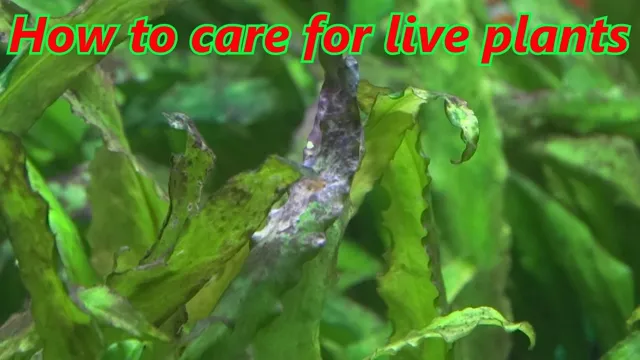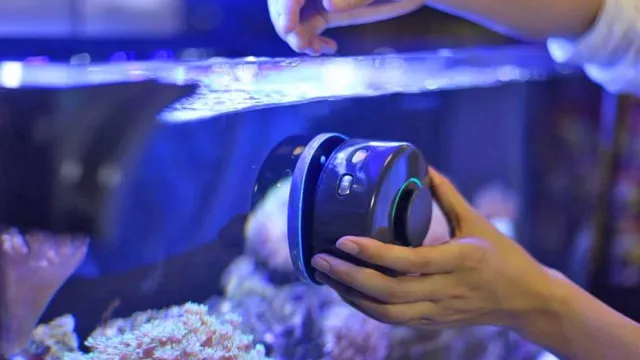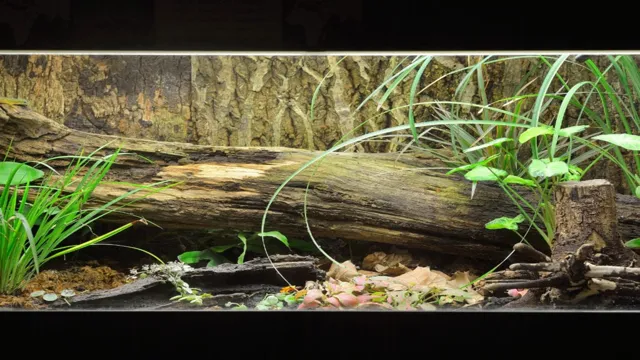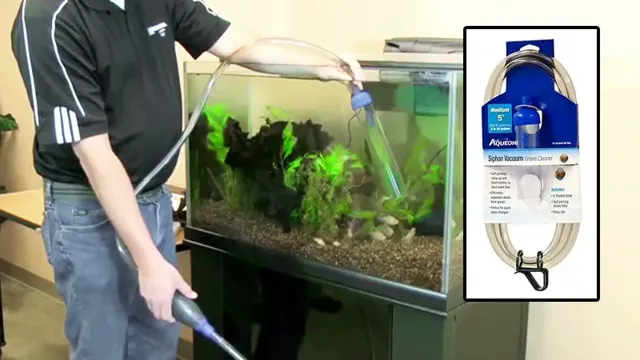Like any living organisms, aquatic plants also need proper care to thrive in your aquarium. Apart from creating a beautiful aquascape, having live plants has numerous benefits. They can oxygenate the water, remove harmful substances, provide a hiding place for fish, and even serve as a food source.
However, keeping plants alive in a tank can be challenging, especially for beginners. If you’re wondering how to care for live plants in your aquarium, a few essential steps can help you create a suitable environment for your aquatic plants. In this blog, we will guide you through the process of keeping your plants healthy and vibrant, so let’s dive in!
Benefits of Live Plants in Your Aquarium
Taking care of live plants in your aquarium comes with several benefits for both you and your fish. Firstly, they help to oxygenate the water, making it healthier for your fish. Live plants also provide a natural habitat for your fish to hide, rest, and play, reducing stress levels and increasing their overall wellbeing.
Additionally, live plants can improve the aesthetic of your aquarium, creating a more natural and beautiful environment. However, to ensure their success, it’s important to know how to care for them properly. This includes ensuring adequate lighting, choosing the right substrate, and providing appropriate nutrients.
Regular maintenance, such as pruning and removing dead leaves, is also necessary to keep your plants healthy. By providing proper care to your live aquarium plants, you can enhance the health and beauty of your aquatic environment.
Improved Water Quality
Having live plants in your aquarium is a fantastic way to improve the water quality and overall health of your aquatic pets. Not only do they add aesthetic value and natural beauty to your tank, but they also help filter out harmful chemicals, neutralize toxins and reduce algae growth. By photosynthesizing, plants take in carbon dioxide and produce oxygen, helping to oxygenate the water and maintain a healthy balance.
In addition, live plants absorb excess nutrients such as nitrates, which can be harmful to fish and cause stress. Peacock fern, Java moss, and Amazon Sword are just a few examples of aquarium plants that are easy to care for and great for water filtration. By incorporating live plants in your aquarium, you can create a healthy and balanced environment for your aquatic pets to thrive and bring life to your living space!
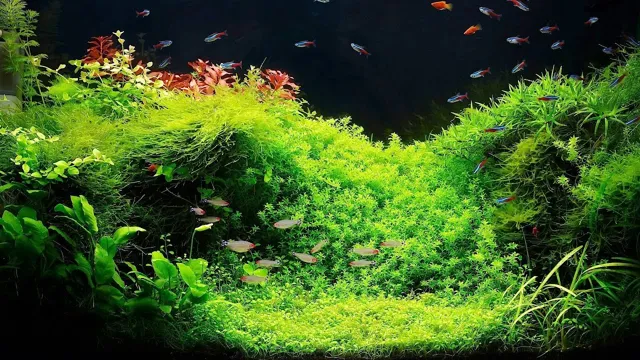
Natural Aquatic Ecosystem
If you’re considering adding live plants to your aquarium, you’re on the right track! Not only do plants add a natural aesthetic to your tank, but they also provide numerous benefits for your aquatic ecosystem. First and foremost, live plants help maintain good water quality by absorbing excess nutrients that can lead to algae growth. Additionally, plants contribute to the oxygen levels in your tank by producing oxygen during photosynthesis.
This can be especially helpful for fish that require high levels of oxygen. Live plants also provide hiding spaces for your fish, which can reduce stress levels and create a more natural environment. Lastly, adding live plants can help create a balanced ecosystem by providing food for herbivorous fish and creating a natural food chain.
So, if you want to promote a healthy and vibrant aquarium, consider incorporating live plants into your setup.
Reduced Algae Growth
One of the many benefits of having live plants in your aquarium is reduced algae growth. Algae growth is a common problem in aquariums and can make your tank look unappealing. However, live plants can help to control algae growth in several ways.
First, they compete with the algae for nutrients, leaving less for the algae to grow on. Second, they help to oxygenate the water, which can also limit algae growth. Finally, live plants provide shelter and hiding places for fish, which can reduce their stress levels and improve their overall health.
So, if you want a beautiful and healthy aquarium, consider adding some live plants. Not only will they enhance the aesthetic appeal of your tank, but they can also help to keep it clean and healthy for your aquatic pets.
Selecting the Right Live Plants for Your Aquarium
When it comes to selecting the right live plants for your aquarium, there are a few things to keep in mind to ensure they thrive and stay healthy. First and foremost, make sure you choose plants that are compatible with the water parameters of your tank. Some plants prefer soft, acidic water, while others thrive in hard, alkaline water.
Additionally, consider the lighting requirements of each plant. Some plants require high levels of light, while others can survive in low light environments. Finally, think about the size of your tank and the growth rate of the plants. (See Also: How to Make Plastic Safe for Aquarium: 5 Tips for Harmless Use)
You don’t want to overcrowd your aquarium or choose plants that will quickly outgrow the available space. With proper selection and care, live plants can add a natural and vibrant element to your aquarium, while also providing important benefits, such as oxygenation and waste removal. So go ahead, embrace your green thumb, and enjoy the beauty and benefits of live plants in your aquarium!
Consider Your Tank Size
When it comes to selecting live plants for your aquarium, it’s important to consider the tank size. A larger tank will give you more freedom for plant options, but a smaller tank requires more careful consideration. If you have a smaller tank, it’s best to choose plants that don’t grow too quickly or spread too much.
You want to avoid overcrowding your tank, which can lead to poor water quality and stressed fish. Some great options for smaller tanks include Java Fern, Anubias, and Cryptocoryne. These plants are easy to maintain, don’t require too much light, and won’t overtake the tank.
In larger tanks, you have a wider range of options, including fast-growing stem plants like Hornwort and Vallisneria. With larger tanks, you can create more complex ecosystems with a mix of plants and fish. Whichever tank size you have, be sure to research the individual needs of each plant and ensure they are compatible with your fish for a healthy and thriving aquarium.
Consider the Lighting and Nutrient Needs of Your Plants
When it comes to selecting live plants for your aquarium, there are a few things you’ll want to keep in mind. First and foremost, consider the lighting requirements of your chosen plants. Some plants do well in low-light conditions, while others require bright, direct light to thrive.
Additionally, you’ll want to make sure you’re providing your plants with the right nutrients. This means choosing plants that are compatible with your aquarium’s water parameters and stocking up on fertilizers and supplements as needed. Consider doing some research on the specific types of plants you’re interested in to ensure that you’re meeting their needs.
By being mindful of both lighting and nutrient requirements, you’ll be able to select live plants that not only look great in your aquarium, but also promote a healthy and sustainable ecosystem for your fish and other aquatic inhabitants.
Choose Hardy and Easy-to-Manage Plants for Beginners
When it comes to selecting live plants for your aquarium, it’s important to keep in mind that not all plants are created equal. As a beginner, it’s best to choose plants that can withstand a wide range of water and lighting conditions. Hardy plants such as Anubias, Java Fern, and Cryptocoryne are great options to start with.
These plants are easy to care for and don’t require too much maintenance. Additionally, it’s important to choose plants that are compatible with the fish and other inhabitants in your aquarium. For example, some fish prefer plants with broad leaves to rest on, while others prefer a more open swimming space.
By selecting the right plants for your aquarium and giving them the proper care they need, you can create a beautiful and healthy underwater environment for your aquatic pets to thrive in.
Planting Live Plants in Your Aquarium
If you’re looking to add live plants to your aquarium, there are a few things you need to know to keep them healthy and thriving. First and foremost, it’s important to choose the right plants for your tank. Some plants require high light and CO2 levels, while others can thrive with lower levels.
Understanding your tank’s parameters and matching them to your plant selection is crucial. Additionally, make sure you’re providing the right nutrients for your plants. Some plants may require specific fertilizers or substrates in order to grow properly.
When planting the plants, be sure to gently remove any dead or decaying leaves and roots from the plant. This helps to prevent any unwanted bacteria or fungi from growing in your tank. Overall, caring for live plants in your aquarium may require a bit more effort, but it’s well worth it in the end when you see your plants flourishing and adding a beautiful element to your tank.
Preparation of Your Aquarium Bed
When setting up your aquarium bed, it’s important to consider adding live plants to create a natural and healthy environment for your fish. Live plants not only provide oxygen and reduce algae growth, but they also serve as great hiding spots for your fish. Before planting, make sure to thoroughly clean your plants and remove any dead or decaying leaves. (See Also: How to Make Your Own Aquarium Plant Substrate: Tips for a Successful DIY Project)
Using a substrate specifically designed for aquatic plants will provide adequate nutrition for their growth. When planting, consider the specific needs of the plants you have chosen, such as their lighting and temperature requirements. With proper care and maintenance, your live plants will thrive and enhance the overall beauty of your aquarium.
Planting Techniques – Anchoring and Burying
When it comes to planting live plants in your aquarium, there are a few important techniques to keep in mind. One of the most important is anchoring. This involves attaching the plants to a sturdy surface (such as a rock or piece of driftwood) to prevent them from floating away or being uprooted.
There are several ways to anchor your plants, including using plant weights, suction cups, or fishing line to tie them down securely. Another important technique is burying the roots of your plants in the substrate. This not only helps to anchor them in place, but also gives them access to essential nutrients and encourages healthy growth.
When burying your plants, make sure to gently press the substrate around the roots to provide a firm hold without damaging them. With these simple techniques, you can ensure that your live plants stay healthy and vibrant in your aquarium for years to come.
Maintaining Your Live Plants in Your Aquarium
Keeping live plants thriving in your aquarium can provide numerous benefits for both your fish and the overall aesthetics of the tank. Proper maintenance of your live plants is essential to ensure they stay healthy and vibrant. One of the most crucial factors in caring for live plants in your aquarium is providing the right conditions.
This includes ensuring that your plants receive adequate lighting, carbon dioxide, and nutrients. Proper water chemistry is also important, and regular water changes can help keep the levels of nutrients and other essential elements balanced. In addition, be sure to prune your plants regularly to remove dead or damaged parts, which can promote new growth.
By giving your live plants the attention and care they need, you can create a beautiful and thriving aquatic environment for your fish to enjoy.
Pruning and Trimming Techniques
Pruning and trimming techniques are essential for maintaining live plants in your aquarium. Keeping your plants well-trimmed not only helps them look better but also promotes healthy growth. It is important to prune your plants regularly, especially when they have overgrown or wilted leaves.
Use sharp scissors or trimming tools to trim back any dead leaves or stems. When pruning, be careful not to damage the healthy parts of the plant. To encourage new growth, cut back the stems at an angle, about ¼ inch above a healthy leaf or node.
It’s also important to keep an eye on your plant’s growth rate and adjust your trimming schedule accordingly. Over-trimming can cause plants to die back or stunt growth. By using proper pruning and trimming techniques, you can ensure that your aquarium plants thrive and add a beautiful touch to your aquatic environment.
Fertilization Requirements and Schedules
When it comes to maintaining your live plants in your aquarium, fertilization is key. Different plants have different requirements, so it’s important to do your research before choosing which plants to include in your tank. Some plants require more nutrients than others, while others require different types of nutrients.
Generally, most aquarium plants benefit from the addition of macronutrients such as nitrogen, phosphorus, and potassium. It’s also important to find a fertilization schedule that works for your plants, which may vary depending on their needs and the size of your tank. Over-fertilization can cause problems such as algae growth, so it’s important to monitor your plants and adjust your fertilization schedule as needed.
In order to keep your live plants healthy and thriving, it’s important to pay attention to their individual needs and the specific requirements of your aquarium system. By doing so, you can create a beautiful and thriving underwater ecosystem.
Avoiding Common Mistakes in Aquatic Plant Care
Maintaining aquatic plants in your aquarium can be a challenging task for any aquarium owner. However, with the right care and attention, live aquarium plants can thrive and enhance the look of your aquarium. One of the common mistakes that aquarium owners make is neglecting to ensure that the plants are receiving adequate light. (See Also: Where to Eat Near Shedd Aquarium: Top 10 Restaurants for a Delicious Bite)
Many aquatic plants require bright lighting for photosynthesis to occur, and insufficient lighting can cause the plants to wilt and die. Another common mistake is overfeeding the fish in the aquarium. Excess feeding can cause an accumulation of waste, which can lead to inadequate water quality and the growth of unwanted algae.
It is essential to feed your fish appropriately and remove any uneaten food to maintain the health of the aquatic plants. Finally, it is crucial to monitor the water parameters regularly and make necessary adjustments to ensure the plants receive the appropriate nutrients. By avoiding these common mistakes and providing the right care and attention, you can enjoy a thriving aquatic plant ecosystem within your aquarium.
Conclusion
In conclusion, caring for live plants in your aquarium requires a bit of patience and effort, but the rewards are well worth it. Just like any other living organism, plants need food, light, and water to survive. Ensuring proper nutrients, lighting, and water parameters will allow them to flourish and add a vibrant touch to your aquatic environment.
Remember to trim, prune, and clean regularly to prevent any unwanted algae growth. And lastly, take pride in the fact that you are providing a healthy and beautiful home for your fish and plants – becoming a true aquascaping master!”
FAQs
What are the benefits of having live plants in an aquarium?
Live plants provide natural filtration, oxygenation, and shelter for fish. They also create a natural and beautiful environment.
How often should live plants be fertilized in an aquarium?
Live plants should be fertilized once a week using a liquid fertilizer designed for aquarium plants.
What is the best lighting for live plants in aquariums?
Live plants need a specific spectrum of light that mimics natural sunlight. LED lights designed for aquariums are the best option.
How do you ensure proper CO2 levels for live plants in an aquarium?
Using a CO2 system or adding a CO2 supplement can help ensure proper CO2 levels for live plants in an aquarium.
How do you prevent algae growth in an aquarium with live plants?
Proper maintenance, including regular water changes and careful feeding, can help prevent algae growth in an aquarium with live plants.
Can live plants be planted in any substrate type?
No, some plants require specific types of substrate, such as nutrient-rich soil or sand. It’s important to research the requirements of the specific plants you want to include in your aquarium.
What are some beginner-friendly live plants for aquariums?
Some easy-to-care-for live plants for aquariums include Java fern, Anubias nana, and Marimo moss balls.

